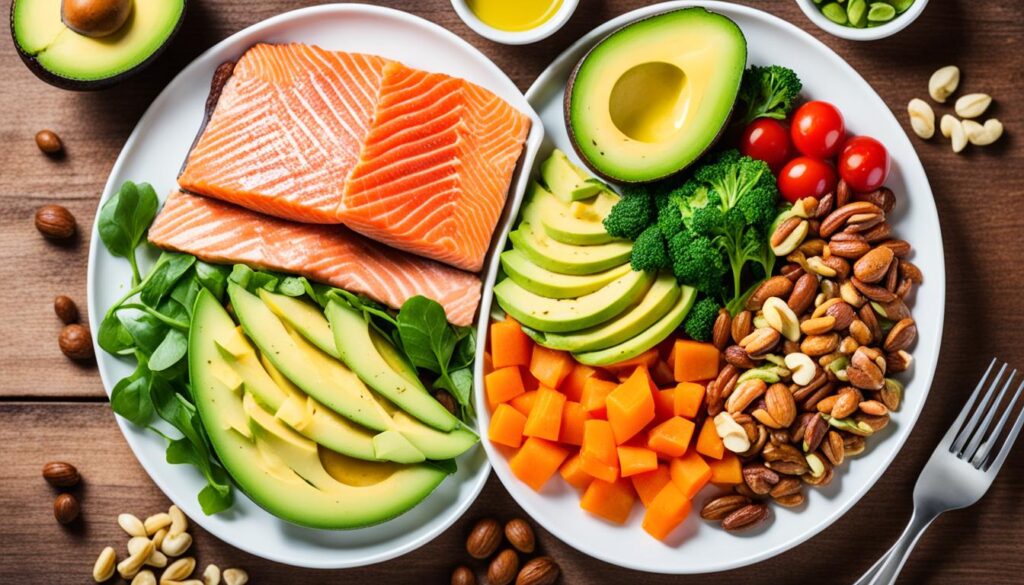Discover how to turn your body into a fat-burning machine. By eating a ketogenic diet and training your body, you can improve your health and fitness. This guide will explain the science of fat adaptation, how to start, and how to boost your fat-burning skills.
Key Takeaways
- Fat adaptation means changing your body to use fats instead of carbs for energy.
- Eating a ketogenic diet helps your body burn fat and make ketones, a great energy source.
- This change is good for your health, makes you last longer during exercise, and helps with weight control.
- Switching to a ketogenic diet means eating fewer carbs and more fats.
- Knowing when your body is adapting to fat will help you do better and see results.
What is Fat Adaptation?
The fat adaptation process changes how your body uses energy. It moves from using mostly carbohydrates to using fat as the main fuel. This switch happens when you follow a low-carb, high-fat diet. Your body then makes ketones, a special energy source that works very well.
Understanding the Metabolic Shift
By eating fewer carbs and more healthy fats, your body changes a lot. It moves from using carbs to using fat for energy. This makes your body very flexible in how it uses energy, switching between glucose and ketones easily.
Benefits of Being Fat-Adapted
- Increased energy and improved endurance: Using fat for fuel gives you a steady energy supply. This helps you stay energized during tough activities.
- Enhanced weight management: Being fat-adapted helps your body burn fat more efficiently. This makes it easier to manage your weight.
- Improved cognitive function: Ketones, the new energy source, protect the brain and improve brain function.
Adapting to fat can change your life. It lets you reach your body’s full potential and enjoy the many benefits of being fat-adapted.
The Science Behind Ketones
When your body is in ketosis, it makes three types of ketone bodies: beta-hydroxybutyrate, acetoacetate, and acetone. These are made from burning fat and can be a great fuel for your body and brain.
Ketone bodies form when your body uses fats instead of carbohydrates for energy. This happens when you eat fewer carbs. The body then uses fat metabolism to make ketone bodies. These can be very good for your health and how well you perform.
- Increased energy production: Ketone bodies are a clean, lasting fuel. They give your body and brain steady energy.
- Improved fat metabolism: Using ketone bodies for energy makes your body burn stored fat more efficiently.
- Enhanced cognitive function: Ketone bodies can get into the brain and be an extra energy source. This might make you think clearer and focus better.
“Ketone bodies are a highly efficient fuel source that can power the body and brain, offering numerous health and performance advantages.”
Knowing how ketones work and how they’re made is key to getting the most out of a ketogenic diet. By using your body’s fat-burning skills, you can gain more energy, focus, and overall health.
Transitioning to a Ketogenic Diet
Starting a ketogenic diet is a big step that needs careful planning. You must cut down on carbs and eat more healthy fats. This change helps your body learn to use ketones for energy instead of glucose.
Carb Reduction and Fat Intake
To switch to a ketogenic diet, you’ll need to eat fewer carbs. Aim for 20-50 grams of carbs a day, based on what you need. At the same time, eat more healthy fats from foods like avocados, nuts, seeds, and oils. This mix of less carbs and more fats is key to getting into ketosis, where your body uses fat for energy.
Overcoming the Keto Flu
- When starting the ketogenic diet transition, you might feel the “keto flu.” This includes tiredness, headaches, and stomach problems.
- These keto flu symptoms happen as your body gets used to using less carbs and more fat consumption.
- To lessen the keto flu, drink plenty of water, get enough electrolytes, and give your body time to adjust to the new way of eating.
With the right attitude and plans, you can get through the tough times of starting a ketogenic diet. You’ll become a strong, fat-adapted person ready to enjoy the benefits of this new way of life.
Signs of Successful “Fat-Adaptation”
As your body gets better at using fat for energy, you’ll see signs of fat adaptation. These signs show how well you’re doing and help you improve your fat-burning skills.
One clear sign is steady energy all day. Unlike the ups and downs from eating a lot of carbs, using fat for energy keeps your energy levels even. This means you won’t feel tired in the afternoon.
Another sign is eating less and feeling less hungry. When your body uses fat for energy, you don’t need to snack as much. This makes it easier to eat less and manage your weight better.
Endurance athletes often notice they can do more without getting tired. This is because they use fat for energy, not just carbs. This lets them go longer without feeling as tired or running out of energy.
Being fat-adapted also means you think clearer and focus better. The steady energy from fat helps your brain work better, making you more focused.
Finally, making lots of ketones is a good sign you’re using fat for energy. Checking your ketone levels shows you’re doing well and staying in a good metabolic state.
| Signs of Fat Adaptation | Benefits |
|---|---|
| Stable energy levels | Consistent supply of energy, avoiding the afternoon slump |
| Reduced appetite and cravings | Improved appetite regulation, easier weight management |
| Enhanced athletic performance | Sustained endurance and reduced fatigue |
| Improved mental clarity and focus | Steady supply of ketones for brain fuel |
| Consistent ketone production | Indication of successful transition to a fat-adapted state |
By watching for these signs, you can make sure your body is using fat as its main energy source. This leads to better health and performance overall.

Exercising in a Fat-Adapted State
When you reach a fat-adapted state, your body gets really good at using fat for exercise fuel. This change helps improve your athletic performance and how long you can keep going.
Optimizing Performance and Endurance
Training in a ketogenic or fat-adapted state brings big benefits. You’ll see a boost in aerobic capacity, letting you work harder for longer. Plus, using fat for energy helps with muscle recovery and cuts down on tiredness.
Top endurance athletes know the strength of fat-adapted endurance. They train their bodies to burn fat well. This saves glycogen stores and boosts their ketogenic athletic performance.
| Benefit | Description |
|---|---|
| Increased Aerobic Capacity | Your body becomes more efficient at utilizing fat as fuel, enhancing your ability to sustain high-intensity exercise. |
| Improved Muscle Recovery | Ketones can provide a more reliable energy source, reducing muscle fatigue and supporting quicker recovery. |
| Enhanced Endurance | By preserving glycogen stores, you can extend the duration of your workouts and push the limits of your athletic performance. |
“When you’re fat-adapted, your body becomes a fat-burning machine, unlocking new levels of endurance and performance.”
Meal Planning for Fat Adaptation
To get and stay in a fat-adapted state, planning your meals is key. Focus on foods high in fat and low in carbs to boost ketone production and fat burning. By balancing your diet with healthy fats and cutting carbs, you can follow a ketogenic diet that supports fat adaptation.
Macronutrient Ratios for Fat Adaptation
The best macronutrient mix for fat adaptation is about 70% healthy fats, 20% protein, and 10% carbs. This mix helps your body use ketones instead of glucose for fuel, making fat burning more efficient.
Incorporating Healthy Fats
Healthy fats like avocados, olive oil, nuts, seeds, and fatty fish should be your diet’s base. These nutrient-dense, low-carb foods give you energy and help make ketones, key for fat adaptation.
Minimizing Carbohydrate Intake
To stay in ketosis and fat adaptation, keep carbs low. Eat low-carb vegetables, berries, and some complex carbs like quinoa or brown rice. Avoid refined and high-glycemic carbs to keep burning fat.
By planning your meals this way, you can easily follow a ketogenic diet meal planning approach. This supports your fat adaptation and overall health.
| Macronutrient | Ratio for Fat Adaptation | Examples |
|---|---|---|
| Fats | 70% | Avocado, olive oil, nuts, seeds, fatty fish |
| Protein | 20% | Lean meats, eggs, dairy, legumes |
| Carbohydrates | 10% | Low-carb vegetables, berries, complex carbs |

“Successful fat adaptation is built on a foundation of well-designed, nutrient-dense meals that fuel your body with healthy fats and minimal carbohydrates.”
Troubleshooting Common Challenges
Starting a fat adaptation journey can be tough. You might face ketogenic diet challenges and hit fat adaptation plateaus. It’s key to know the common problems and how to fix them. This way, you can keep your metabolism flexible and keep burning fat effectively.
Overcoming Plateaus and Stalls
Many people on a ketogenic diet hit a plateau where weight loss stops. This can happen for many reasons, like stress, hormonal changes, or needing to change your diet and exercise. Here are some tips to get past these plateaus:
- Check your macronutrient balance to make sure you have the right mix of carbs, fats, and proteins.
- Try intermittent fasting or cyclical ketosis to kickstart your metabolism again.
- Boost your exercise and add strength training to increase your metabolic flexibility.
- Fix any issues like stress or poor sleep that might be slowing you down.
By being proactive and tackling challenges head-on, you can smoothly move through the process of fat adaptation. This will help you enjoy all the perks of a ketogenic lifestyle.
| Common Ketogenic Diet Challenges | Troubleshooting Strategies |
|---|---|
| Ketogenic diet plateaus | Adjusting macronutrient ratios, incorporating intermittent fasting, increasing physical activity |
| Lack of metabolic flexibility | Experimenting with cyclical ketosis, focusing on overall health and wellbeing |
| Persistent keto flu symptoms | Ensuring adequate electrolyte and hydration levels, adjusting dietary intake |
By listening to your body and using effective strategies, you can beat the common hurdles of the ketogenic diet. This will help you fully enjoy the benefits of fat adaptation.
Fat Adaptation for Weight Loss
Becoming fat-adapted can help you lose weight and improve your body composition. It means your body uses fat as its main fuel instead of carbs. This can make you feel less hungry, improve how your body handles insulin, and burn fat more efficiently.
Keeping an eye on your progress is key. You can track your success by measuring your body weight, body fat percentage, and other important factors. This helps you see if your fat adaptation plan is working and lets you make changes to reach your goals.
Tracking Progress and Measurements
It’s important to monitor your progress on a fat adaptation journey. Here are some key measurements to track:
- Body weight: Keep a close eye on your overall weight changes, as fat adaptation can lead to significant reductions in body weight.
- Body fat percentage: Use a reliable method, such as a body composition analyzer or skinfold calipers, to measure your body fat percentage over time.
- Waist circumference: Track changes in your waist measurement, as a decrease can indicate a reduction in abdominal fat.
- Energy levels and cognitive function: Pay attention to how you feel, as improved energy and mental clarity can be signs of successful fat adaptation.
| Measurement | Initial Value | 4 Weeks | 8 Weeks | 12 Weeks |
|---|---|---|---|---|
| Body Weight (lbs) | 185 | 180 | 175 | 170 |
| Body Fat (%) | 28% | 25% | 22% | 19% |
| Waist Circumference (inches) | 36 | 34 | 32 | 30 |
By keeping an eye on these key indicators, you can track your progress. This lets you adjust your diet and exercise to make sure your fat adaptation is working well for weight loss and better body composition.
Integrating Intermittent Fasting
Starting your fat adaptation journey? Adding intermittent fasting can be a game-changer. It helps your body switch between using fat and ketones for energy when you’re not eating. This can boost your fat loss, make insulin work better, and offer other health perks. It’s a great addition to a ketogenic lifestyle.
Intermittent fasting means eating in cycles, alternating between fasting and eating. When you’re fat-adapted, your body gets better at using stored fat for energy during fasts. This lets you enjoy the best parts of this method. By planning your meals and fasting times, you can burn more fat and easily get into ketosis.
| Benefits of Integrating Intermittent Fasting | Potential Fasting Benefits |
|---|---|
|
|
Adding intermittent fasting to your fat adaptation plan can bring great benefits. Try different fasting methods, like time-restricted eating or longer fasts, to see what suits you best. With time and consistency, you can fully benefit from fat adaptation and intermittent fasting. This can lead to better health and a new body.
Long-Term Sustainability
Keeping up with a sustainable fat adaptation and ketogenic lifestyle needs a flexible plan. Some people might stay in ketosis all the time. Others might switch in and out of it. This cyclical ketosis helps keep your body flexible, avoids side effects, and makes the diet easier to follow over time.
The Advantages of Cyclical Ketosis
Switching between ketosis can bring many benefits for those on a sustainable fat-adapted path:
- It makes your body good at using both glucose and ketones for energy.
- It might lessen the keto flu symptoms when changing states.
- It helps you stick with the ketogenic diet by giving you breaks from strict carb limits.
- It could help keep hormone levels and health in check by mixing in non-ketogenic phases.
Using a cyclical ketosis method lets you enjoy fat adaptation. At the same time, it keeps your ketogenic lifestyle flexible and easy to follow.
“Sustainable fat adaptation is not about perfection, but about finding a balance that works for your individual needs and preferences.”
For lasting sustainable fat adaptation, it’s important to find the right mix of ketosis and carb refeeds. Pay attention to your body and try different methods. This way, you can find the metabolic flexibility that suits you best.
Conclusion
Fat adaptation changes how your body uses energy, offering many health and fitness benefits. By learning about ketones and the ketogenic diet, you can make your body burn fat for fuel. This is a powerful way to improve your health and manage your weight.
Switching to fat adaptation can boost your energy and endurance. It also helps with weight control and overall health. You’ll enjoy steady energy, better brain function, and a healthier body.
To keep seeing these benefits, you need a lifestyle that supports fat adaptation. With the right strategies and dedication, you can fully benefit from this approach. Next, look into meal planning, solving common issues, and adding intermittent fasting to boost your results.


